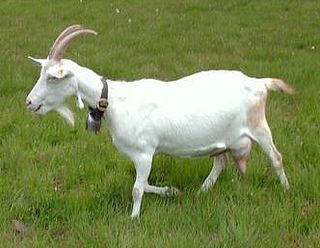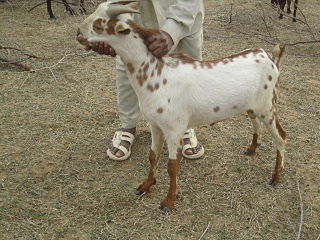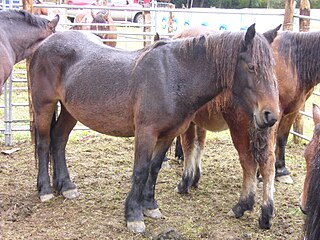
The Angora or Ankara is a Turkish breed of domesticated goat. It produces the lustrous fibre known as mohair. It is widespread in many countries of the world. Many breeds derive from it, among them the Indian Mohair, the Soviet Mohair, the Angora-Don of the Russian Federation and the Pygora in the United States.

The American Pygmy is an American breed of achondroplastic (dwarf) goat. It is small, compact and stockily built. Like the Nigerian Dwarf, it derives from the West African Dwarf group of breeds of West Africa. Between 1930 and 1960, animals of this type were imported to the United States for use either as zoo animals or for research; some were later kept and bred as companion animals and established as a breed in 1975.

The Saanen is a Swiss breed of domestic goat. It takes its name from the Saanental in the Bernese Oberland, in the southern part of the Canton of Bern, in western Switzerland. It is a highly productive dairy goat and is distributed in more than eighty countries worldwide.
The Poney du Logone is a breed of small horse or pony from the area of the Logone River in Chad and Cameroon, in west central Africa. It is particularly associated with the Musey or Moussey people of that region, and may also be known as the Poney Musey or Poney Mousseye.

The Mallorquín or Caballo Mallorquín is a rare breed of horse indigenous to the island of Mallorca in the Balearic Islands, from which it takes its name. Identification of the breed was begun in 1981 by the Patronato para las Razas Autóctonas de Mallorca. The Mallorquín is listed in the Catálogo Oficial de Razas de Ganado de España in the group of autochthonous breeds in danger of extinction.

The Ukrainian Grey is an ancient Ukrainian breed of Podolian cattle. It is a hardy breed, and was traditionally used both for meat and for draught power. It is similar to other European steppe cattle breeds such as the Hungarian Grey and the Italian Podolica.

The Golden Guernsey is a rare breed of dairy goat from Guernsey in the Channel Islands, where it has been known for more than two hundred years.
The Unmol is a rare breed of horse from the north-western Punjab, in Pakistan. In 1995 its conservation status was listed by the FAO as "critical" and the breed was described as "nearly extinct". The subsequent (third) edition of the World Watch List for Domestic Animal Diversity, published in 2000, does not mention it; nor was it among the breeds listed in the Global Databank for Animal Genetic Resources in 2007. Unmol horses are or were usually bay or grey. There are or were a small number in India.

The Appenzell, French: Chèvre d’Appenzell, German: Appenzellerziege, is a rare and endangered indigenous breed of white domestic goat from Switzerland. It originates in the "half-cantons" of the historic Appenzell region, Appenzell Ausserrhoden and Appenzell Innerrhoden, and has spread into the neighbouring Canton of St. Gallen.

The Barbari or Bari is a breed of small domestic goat found in a wide area in India and Pakistan. It is distributed in the states of Haryana, Punjab and Uttar Pradesh in India, and in Punjab and Sindh provinces of Pakistan.

The Irish Goat is a traditional Irish breed of domestic goat. It is a dual-purpose breed, used both for meat and for milk. It is an endangered breed and may survive only in feral populations. It is distinct from the feral Bilberry Goat of Waterford.
The Laoshan goat breed from the Shandong Province of China is used for the production of milk. It is derived from the selective breeding of local goats crossed with Saanen goats first introduced to the area in 1904.

The Poitou goat is a dairy goat breed from western France. With a history dating back to 1800, the breed is named for the Poitou historic province. Poitou goats are known for their use in goat milk cheese production, though they are an endangered breed, and at one point were down to just 600 breeding animals. Poitou goats have a distinctive appearance: tall and with long, shaggy hair, they are black-brown with white marks on the head and neck, while the underbelly and legs are white.

The Valais Blackneck is a breed of domestic goat from the canton of Valais, in southern Switzerland, and neighbouring areas of northern Italy. The largest concentration is in the area of Visp (Viège). It is present in modest numbers in Austria and Germany. It is known by many names, including German: Walliser Schwarzhalsziege or Gletschergeiss; French: Col Noir du Valais, Chèvre des Glaciers or Race de Viège; and Italian: Vallesana or Vallese.

The Jaca Navarra, or Navarrese Horse, is a Spanish breed of small horse from the autonomous community of Navarre in the north-eastern part of the country. In 2013 it was listed in the Catálogo Oficial de Razas de Ganado de España in the group of autochthonous breeds in danger of extinction. The total population of the Jaca Navarra has been variously estimated at 350, 250, and 240 and decreasing. In April 2011 the total population was reported to be 899, all of which were in Navarre. In 2000, and again in 2007, it was listed by the FAO as endangered.

The Bianca Modenese or Modenese is a breed of dual-purpose cattle from the Po Valley, in the Emilia Romagna and Lombardy regions of northern Italy. It is raised for beef and milk production, but in the past was a triple-purpose breed, used also as a draught animal. The name derives from that of the province of Modena, where it is thought to have originated. In the nineteenth century it was concentrated in the area of Carpi, and was sometimes known as the Carpigiana. It was later distributed through much of the Po Valley, and thus also known as the Bianca della Val Padana.

Animal genetic resources for food and agriculture (AnGR), also known as farm animal genetic resources or livestock biodiversity, are genetic resources of avian and mammalian species, which are used for food and agriculture purposes. AnGR is a subset of and a specific element of agricultural biodiversity.

The Red Engadine or Engadine Red is a traditional Swiss breed of domestic sheep from the Lower Engadine valley and some neighbouring parts of Bavaria and Tyrol. It derives from cross-breeding of stock of Bergamasca and Alpines Steinschaf type. It is characterised by its convex profile, its fox-red wool and its long lop ears. In the 1980s it became gravely endangered, but has since recovered. It is a hardy mountain sheep; the hooves are strong and hard, and the breed is one of the few that are reported to have good resistance to foot rot.

The State of the World's Animal Genetic Resources for Food and Agriculture is a major report on the genetic resources of breeds of farm livestock in the world. It was published by the Food and Agriculture Organization of the United Nations (FAO) in 2007. It covers mammalian and avian domestic livestock breeds, but does not include fish or honey bees and other invertebrates. It is based on information submitted to the FAO, in the form of reports of participating countries, thematic studies prepared by experts and data on individual breeds submitted to DAD-IS. An annex to the report, the List of breeds documented in the Global Databank for Animal Genetic Resources, gives an estimate of conservation status for all breeds for which sufficient data had been received. The report has been translated into Arabic, Chinese, French, Indonesian, Russian and Spanish.

The Pygmy is a British breed of dwarf goat. It is small, compact and generally stockily built. It was established in the 1980s by fusion of the various miniature goat populations of the United Kingdom into a single breed. These were of two principal types: a stocky achondroplastic type derived from the West African Dwarf group of breeds of West Africa; and a small but well-proportioned type derived from the Southern Sudan goat.

















